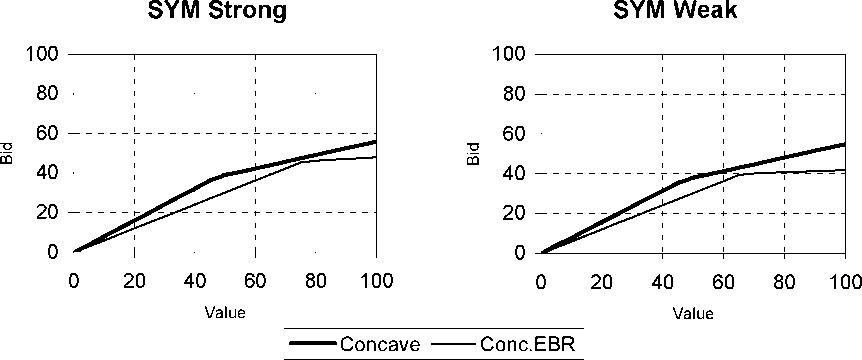CRRA bidding for 11 subjects (and for 12 subjects in the last 25 rounds), which does not
represent a significant success rate according to the Binomial test either.

Figure 6: Average Concave Bid Functions in SYM
As far as the frequency of matched shapes can be used as a proxy for best-reply behavior, the
above analysis in terms of (four possible) shapes would suggest that the extent of best-reply
behavior is roughly the same across types within a treatment but that it changes across
treatments, especially between symmetric and asymmetric treatments. In the aggregate, the
observed shapes match the EBR ones in 48% of times in LOW, in 40% of times in MIX and
in 61% of times in SYM, so that subjects would be closer to best reply bidding in symmetric
settings than in the more complex bidding environment of asymmetric settings.
4. Summary and Conclusion
We report on a series of experiments that were designed to assess the strategic considerations
that underlie the Nash equilibrium predictions for first-price sealed bid auctions with
independent private values. The outcomes indicate that the observed behavior supports the
basic Nash equilibrium predictions for risk neutral or risk averse bidders: i) Strong bidders bid
less aggressively than Weak bidders in the asymmetric bidding environments but not in the
27
More intriguing information
1. Valuing Farm Financial Information2. Education Responses to Climate Change and Quality: Two Parts of the Same Agenda?
3. Regionale Wachstumseffekte der GRW-Förderung? Eine räumlich-ökonometrische Analyse auf Basis deutscher Arbeitsmarktregionen
4. The name is absent
5. The name is absent
6. Plasmid-Encoded Multidrug Resistance of Salmonella typhi and some Enteric Bacteria in and around Kolkata, India: A Preliminary Study
7. Luce Irigaray and divine matter
8. PROTECTING CONTRACT GROWERS OF BROILER CHICKEN INDUSTRY
9. Educational Inequalities Among School Leavers in Ireland 1979-1994
10. Strategic Investment and Market Integration